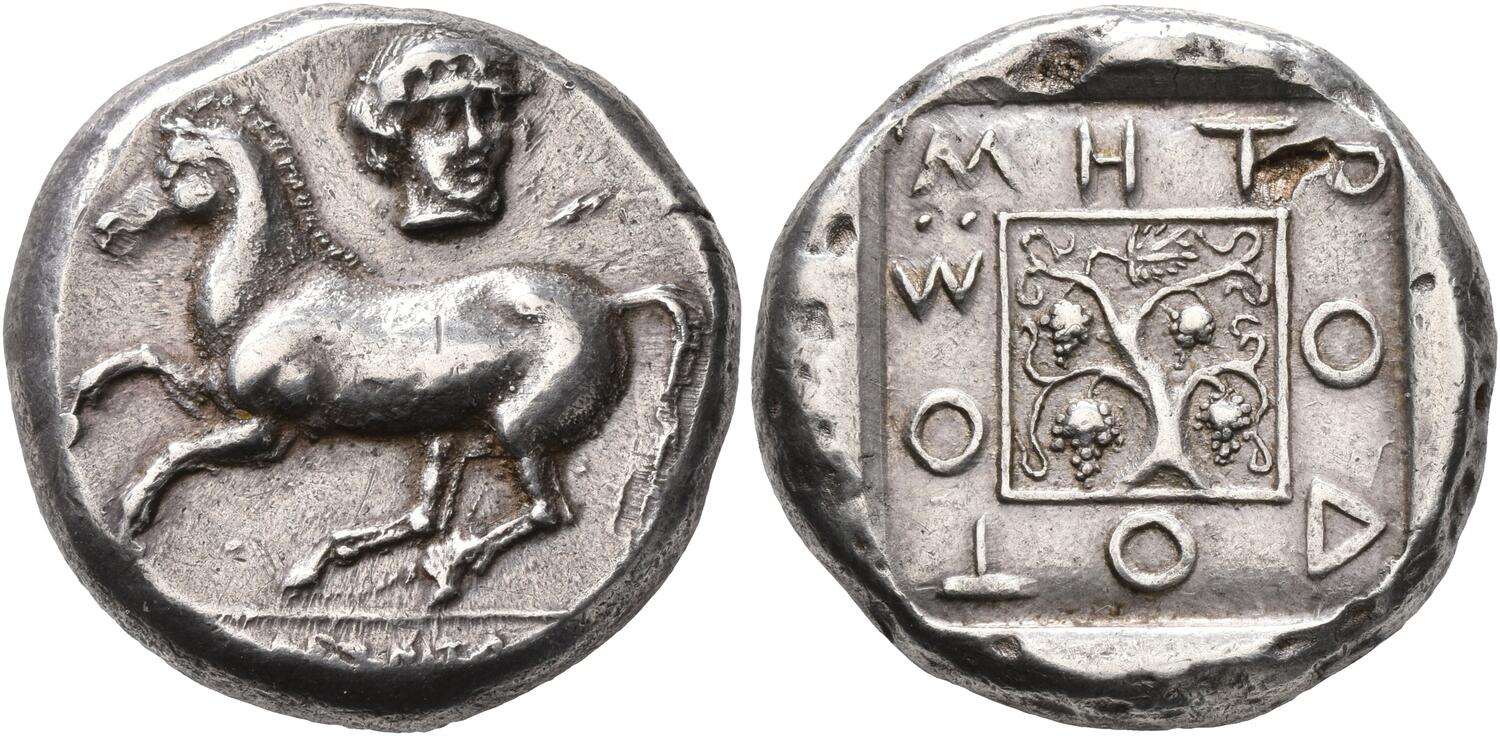AC 135 - Maroneia, silver, tetradrachms (436/5-411/0 BCE)
From SILVER
436 BCE - 411 BCE Silver 17,686 kg
Description
| ObverseInscription or printing placed on the obverse.: | MAPΩN (Greek).Bridled horse springing to left, with trailing rein, above, wreathed head of Apollo facing slightly to right. |
| ReverseInscription or printing placed on the reverse.: | MHT-POΔ-OT-OΣ (Greek).MHT-POΔ-OT-OΣ: around linear square containing grape vine with four bunches of grapes, all within incuse square. |
Mint and issuing power
| MintIdentifies the place of manufacture or issue of a numismatic object.: | Maroneia | Ancient regionAncient region.: | Thrace | Modern countryModern country: Greece | AuthorityIdentifies the issuing power. The authority can be "pretended" when the name or the portrait of X is on the coin but he/she was not the issuing power. It can also be "uncertain" when there is no mention of X on the coin but he/she was the issuing power according to the historical sources: |
Chronology
| FromIdentifies the initial date in a range assigned in a numismatic context. | 436 BCE | toIdentifies the final date in a range assigned in a numismatic context.. | 411 BCE | PeriodTime period of the numismatic object.: Classical 480-323 BC |
Physical description
| MetalThe physical material (usually metal) from which an object is made.: | Silver |
Median weightMedian of the weights of numismatic objects (in grams). in grams | 13.95 | DenominationTerm indicating the value of a numismatic object. Examples: tetradrachm, chalkous, denarius.: | tetradrachm |
StandardStandard.: |
Image

AC135 Maroneia.jpeg [1]
References
| Die study referencePublication of the study: | Schönert-Geiss 19871Schönert-Geiss 1987, n° 85-153 | ||
| Coin series referenceReference to coin series study: | RQEMAC2RQEMAC, n° 135 | ||
Obverse dies distribution
| FrequencyFrequency of specimen in distribution. ᵖ | Number of obversesNumber of obverse dies. ᵖ (o) | % (o) | Number of coinsNumber of coins. (n) | % (n) | Die nameName(s) of the die(s). |
| 1 | 23 | 52.27 | 23 | 22.12 | 1, 2, 4, 6, 7, 8, 10, 12, 13, 14, 16, 17, 18, 19, 20, 25, 26, 29, 30, 33, 37, 41, 43 |
| 2 | 8 | 18.18 | 16 | 15.38 | 9, 21, 23, 24, 34, 35, 36, 42 |
| 3 | 4 | 9.09 | 12 | 11.54 | 5, 22, 32, 39 |
| 4 | 3 | 6.82 | 12 | 11.54 | 15, 38, 40 |
| 5 | 2 | 4.55 | 10 | 9.62 | 3, 44 |
| 6 | 2 | 4.55 | 12 | 11.54 | 27, 31 |
| 9 | 1 | 2.27 | 9 | 8.65 | 11 |
| 10 | 1 | 2.27 | 10 | 9.62 | 28 |
| Total | 44 of 44 | 100 | 104 of 104 | 100.01 |
Reverse dies distribution
no distribution is available
Quantification
| Number of obversesNumber of obverse dies. ᵖ (o) | 44 | Number of singletons (o1)The number of singleton coins. ᵖ | 23 |
| Number of reverse diesNumber of reverse dies. (r) | 59 | Number of coinsNumber of coins. (n) | 104 |
| Coins per obverse dieNumber of coins per obverse die. (n/o) | 2.36 | Coins per reverse dieNumber of coins per reverse die. (n/r) | 1.76 |
| Reverse per obverse ratioRatio of obverse dies divided by reverse dies. (r/o) | 1.34 | Percentage of singletons (o1)number of coins (n) divided by the number of singletons (o1) ᵖ | 52.27 % |
| Original number of dies (O) (Carter 1983 formula)The estimation of the number of coins according to Carter 1983 ᵖ | 63.39 | Coins struck if 20,000 as average productivity per dieCoins made if the average productivity for obverses (according to Carter) is 20,000. ᵖ | 1,267,800 |
| Original number of dies (O) (Esty 2011 formula)The estimation of the number of coins according to the singleton formula in Esty 2011 ᵖ (O) | 76.27 | Survival rate if 20,000 as average productivity per dieSurvival rate if average productivity is 20,000. ᵖ | 0.00008 |
| Coverage (o = % of O) (Esty 1984 formula)Esty 1984 - coverage (% of O) ᵖ (o = % of O) | 77.88% | Die productivity if survival rate 1/2,000Average productivity if survival rate is 1/2,000. ᵖ | 3,281.27 |
| Weight of silver (in kg) if 20,000 coins per die (O = Carter formula)Carter 1983 * Median weight * 20000 (*10 if gold or electrum) ᵖ | 17,686 kg <br /> 17,686 kg | Die productivity if survival rate 1/5,000Average productivity if survival rate is 1/5,000. ᵖ | 8,203.19 |
Remarks